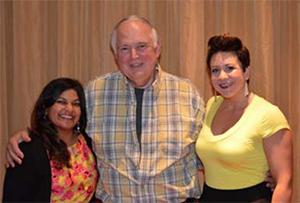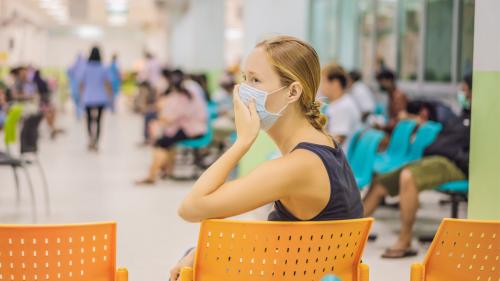
-
Understanding primary immunodeficiency (PI)

Understanding PI
The more you understand about primary immunodeficiency (PI), the better you can live with the disease or support others in your life with PI. Learn more about PI, including the various diagnoses and treatment options.
-
Living with PI
-
Addressing mental health
-
Explaining your diagnosis
- General care
- Get support
- For parents and guardians
-
Managing workplace issues
- Navigating insurance
-
Traveling safely

Living with PI
Living with primary immunodeficiency (PI) can be challenging, but you’re not alone—many people with PI lead full and active lives. With the right support and resources, you can, too.
-
Addressing mental health
-
Get involved

Get involved
Be a hero for those with PI. Change lives by promoting primary immunodeficiency (PI) awareness and taking action in your community through advocacy, donating, volunteering, or fundraising.
-
Advancing research and clinical care
-
Research Grant Program
-
Consulting immunologist
-
Diagnosing PI
-
Getting prior authorization
-
Clinician education
-
Survey research
-
Participating in clinical trials

Advancing research and clinical care
Whether you’re a clinician, researcher, or an individual with primary immunodeficiency (PI), IDF has resources to help you advance the field. Get details on surveys, grants, and clinical trials.
-
Research Grant Program
Dr. James Heath, president and professor at the Institute for Systems Biology (ISB), a non-profit research institute in Seattle; professor of molecular and medical pharmacology at the University of California Los Angeles (UCLA); and director of the National Cancer Institute-funded NSB Cancer Center, recently presented the Immune Deficiency Foundation (IDF) Forum, “Long COVID in the Primary Immunodeficiency Community,” in which he outlined the findings of a study conducted by ISB and the Swedish Medical Center on the origins of long COVID.
The study followed about 310 patients beginning in March 2020, before long COVID became a recognized public health crisis. Long COVID is characterized by a person continuing to suffer from symptoms months, and even years, after they’ve tested positive for the SARS-CoV-2 virus. Importantly, long COVID is distinct from chronic infection—those suffering from long COVID test negative for the virus, but continue to experience symptoms.
“At the time, no one was thinking about long COVID. But when we got our patients to consent to our study, we wanted to follow them not just through acute disease but out through recovery as well, and as long COVID became more and more reported, we realized we had the opportunity to understand a little bit about the nature of long COVID,” said Heath.
Researchers followed patients for three months post-infection and gathered a tremendous amount of data on each person. They performed blood draws—one right at diagnosis, one at the peak stage of disease, and one 2-3 months after diagnosis; executed a thorough analysis of health history records and had participants complete health questionnaires; and examined proteins, circulating immune cells, antibodies, autoantibodies, and viral load to sample the patient’s immune system in as many ways as possible. They then integrated the data and examined the results.
“It’s important to understand the depth at which we’ve looked at these patients, which is absolutely critical to trying to understand something that is heterogeneous and in many ways is as vaguely defined as long COVID. It’s almost as if every patient looks a little bit different,” said Heath.
“These patients spanned the rate of severity. Some were outpatients the entire time. Some of the patients were basically in the hospital and on respirators.”
Long COVID symptoms (2-3 months out from diagnosis), listed from most common to least common, were:
Fatigue.
Cough.
Taste disorder.
Headache.
Difficulty concentrating.
Diarrhea.
Joint pain.
Heart palpitations.
Chills.
“Patients that had severe disease are more likely to have long COVID but not a lot more likely. It turns out the patients with mild infections also have a high probability of developing long COVID,” said Heath.
Out of all pre-existing health conditions, type 2 diabetes was most likely to result in long COVID symptoms.
“It’s a major factor to anticipate whether or not you will develop long COVID,” said Heath. “We had about 50 or so patients with diabetes. And we could say with some certainty that type 2 diabetes is going to lead to long COVID symptoms and by and large those long COVID symptoms just spanned the range from neurological to fatigue and respiratory symptoms.”
In addition to determining which pre-existing conditions correlate with long COVID, researchers also wanted to define long COVID, to provide greater insight on treatment.
“In many of the patients that we’ve interacted with, they have a great deal of frustration with the medical system because they’ll go and they know things are wrong and yet there’s not a clean diagnosis,” said Heath.
Researchers discovered that patients with neurological problems, sometimes referred to as brain fog, had a disrupted circadian rhythm—the natural internal process that regulates the sleep/wake cycle over a period of 24 hours.
They also found that those who had flu-like symptoms, such as respiratory problems and fatigue, had very low cortisol, an essential hormone in the body that regulates a wide range of processes including the immune response.
“This seems to be intrinsic to these patients that have these respiratory viral-like symptoms. So, this seems to be something that may be treatable, and I think some physicians are beginning to use cortisol replacement therapy in the treatment of patients,” said Heath.
Another aspect researchers considered in their efforts to define long COVID was the reactivation of other viruses. There were some indications in the literature that COVID-19 wakes up viruses that are dormant in the body, explained Heath.
Researchers found that about 20% of patients experienced a reactivation of Epstein-Barr virus (EBV) and that a subset of patients continued to carry high levels of the SARS-CoV-2 virus in their system.
“When we look at these two viral signatures in patients that are recovered and convalescing … what we find is that these viral signatures by and large associate with neurological long COVID, things like memory problems and difficulty concentrating,” said Heath.
Researchers also looked at autoantibodies—antibodies made by a person that attack the person’s own cells. They measured a host of autoantibodies including the autoantibody that is associated with neutralizing a person’s type 1 alpha interferon (which can anticipate fatal covid infections, especially in older individuals) and the autoantibody that is associated with lupus. A COVID study a year and a half ago identified the presence of atypical memory B cells, which are cells associated with lupus.
Importantly, the majority of patients had autoantibodies at recovery but also at official diagnosis and those autoantibodies were mature, meaning that the autoantibodies predate the infection.
About 20% of patients in the study had autoantibodies at a subclinical level, which means that tests performed by a standard clinical lab would not have detected them because clinics only test at a level where symptoms are displayed.
“They’re at subclinical levels but that doesn’t mean that they’re not important. They actually are important for long COVID, they’re just at lower levels than what would come back in a clinical lab,” explained Heath.
The study also showed that for the patients who did have very high levels of autoantibodies at a clinical level, there were immunological signatures such as higher levels of atypical memory B cells.
“These autoantibodies absolutely affected the disease journey the patient takes through a COVID-19 infection, but there are also past factors that anticipate long COVID,” said Heath.
“The other thing this establishes is that, on some level, there is a relationship between some patients suffering from long COVID and lupus and that’s an avenue that we’re really aggressively pursuing now and with luck, it may lead to potential treatments.”
In their work on single-cell biology, the researchers found that in some patients, their T cells continued to aggressively expand despite the acute symptoms of COVID being over and that T cells against other viruses were also aggressively expanding in those patients.
“It’s a non-specific immune response, but it’s basically chronic inflammation that is in the T cell compartment that is associated with gastrointestinal long COVID, probably because that’s a late-developing symptom compared to the other ones,” he said.
The challenge for providers is putting all the pieces together to determine the best course of treatment.
“These different factors that we see that anticipate long COVID, how are they related? How am I the physician supposed to think about them? Is there one drug that can cover all these factors or is there going to be many drugs?” said Heath.
“What we found was very interesting. What we’ve shown is the relationship between all these different autoantibodies, type 2 diabetes, the different viral measurements that we made of EBV virus and SARS-CoV-2, and some of these past factors are somewhat dependent upon each other and there is perhaps a limited number of therapies to address the impact of these past factors.”
While at diagnosis a provider may be able to see the correlation, once a few months have passed, the relationship dissolves.
“This is oftentimes what physicians see when you go to them. You’ve got this vague set of symptoms and it’s crazy hard to track back, where did these symptoms come from? This is one of the challenges of this and other chronic diseases. The issue is that your body just scrambles that information over time,” he said.
“It’s actually there, you can capture it when the infection happens, and that triggering event that ultimately leads to long COVID happens, but once you have the long COVID it’s very, very hard to go back in time and determine what caused it.”
In summary, each of these conditions explained about 30% of long COVID:
Reactivation of EBV or the SARS-CoV-2 loads in the blood accounts for about one-third of long COVID cases, with 14% presenting with neurological symptoms and 25% resulting in neurological and fatigue symptoms, sputum production, and mortality.
Type 2 diabetes accounts for another third of long COVID, with 22% exhibiting respiratory viral symptoms.
Autoantibodies account for 67% of the long COVID cases, with some patients having both autoantibodies and either type 2 diabetes or virus reactivation. Symptoms include sputum production, gastrointestinal issues, inability to exercise, cough, loss of taste, and neurological problems.
Heath said that there is now a national study on long COVID looking at thousands of patients over a four-year period. Learn more at the National Institute of Health’s Researching COVID to Enhance Recovery (RECOVER).
This page contains general medical and/or legal information that cannot be applied safely to any individual case. Medical and/or legal knowledge and practice can change rapidly. Therefore, this page should not be used as a substitute for professional medical and/or legal advice. Additionally, links to other resources and websites are shared for informational purposes only and should not be considered an endorsement by the Immune Deficiency Foundation.
Related resources
Sign up for updates from IDF
Receive news and helpful resources to your cell phone or inbox. You can change or cancel your subscription at any time.





The Immune Deficiency Foundation improves the diagnosis, treatment, and quality of life for every person affected by primary immunodeficiency.
We foster a community that is connected, engaged, and empowered through advocacy, education, and research.
Combined Charity Campaign | CFC# 66309




